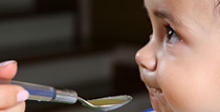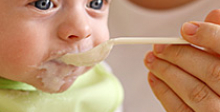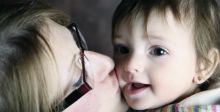Internal mini form
Contact Us Today
Eating healthy foods and participating in regular exercise is an important aspect of maintaining overall health. That’s not something that changes if a person has a disability; in fact, the cultivation of healthy habits will serve an individual with Cerebral Palsy well throughout life.
Whether it’s making sure that a child has the proper level of nutrients, that the texture is palatable, or that the pace allows for appropriate digestion, encouraging a child to eat right can be essential, especially if the child has oral motor dysfunction or dysphagia. Some children need supplemental diets and nutrition while others in the household need separate meal preparation. Families touched by Cerebral Palsy may turn to the help of registered dieticians, speech and language pathologists and government assistance to meet familial needs.
Gastrointestinal, nutritional and dietary concerns
Most children with Cerebral Palsy are at risk for secondary undernourishment due to feeding difficulties and oral motor dysfunction. Oral motor dysfunction is the inability to control muscles in the mouth required for proper food intake levels. Children with Cerebral Palsy can benefit from feeding and nutrition assessments.
A study published July 1, 1999 by Elsevier titled “Gastrointestinal manifestations in children with Cerebral Palsy” found the majority (92 percent) of those with Cerebral Palsy had one or more significant gastrointestinal symptoms, including difficulty swallowing, regurgitation, abdominal pain, chronic pulmonary aspiration, and chronic constipation.
Elsevier also found 93 percent of those with trouble swallowing had oral dysfunction and/or pharyngeal phase swallowing difficulties. Swallowing occurs in three phases. Difficulties in swallowing can occur at one or more of the phases:
- Oral phase – food is placed in the mouth, moistened and chewed to proportionally size the food for passage to the pharynx.
- Pharyngeal phase – sensory receptors activate involuntary and rhythmic contractions that push the food from the pharynx to the esophagus. The larynx temporarily inhibits breathing to protect the lungs.
- Esophageal phase – food progresses from the esophagus to the stomach through rhythmic contractions. Esophageal sphincters open and close to provide physical barriers to avoid regurgitation.
Focus treatment on proper nourishment
The focus of treatment is to prevent or treat undernourishment, while improving oral motor skills. To do so, a multi-disciplinary team of clinical dietitians, nurses, feeding therapists (occupational therapist, speech/language pathologist or physiotherapist), pediatricians, radiologists, pediatric dentists, neurologists and otorhinolaryngologists (ear, nose and throat specialist) may be called upon to assess, formulate, manage, and monitor the child’s dietary intake and ability to consume. The experts required will depend on the severity of the child’s condition, the problems experienced, and the discretion of the child’s primary care physician.
Monitor gastrointestinal health with imaging technology
CT scans or magnetic resonance imaging (MRI) may be ordered to assess gastrointestinal health and aspiration. Intraesophageal pH can be monitored or an upper GI endoscopy may be required to determine reflux and vomiting disorders. Eating ability and nutritional needs can be evaluated. Body mass index and fat-free mass can be compared to the child’s age, height, weight and form of Cerebral Palsy to gauge growth and developmental level. The length of time for feeding and the severity of impairment will help determine feeding strategy.
Improve nutritional status through nutritional interventions and rehabilitation
The multi-disciplinary team of experts is likely to recommend timely rehabilitation and nutritional interventions to improve nutritional status and quality of life. Nutritional interventions may include increasing the quality of food, increasing fluid intake, and forming individualized meal plans with specified quantities and consistencies of food. High energy nutrition supplements may be required. Medications (prokinetic drugs, antacids and gastric enzyme inhibitors) may be prescribed.
Therapy may improve head control, feeding skills, and speech. Surgeries and feeding tube options may be considered, including:
- Nasoeteric, or enteric
- Pecutaneous endoscopic gastrostomy, or PEG
- Gastrojejunal, or GJ tube
Feeding technique instruction can improve feeding mechanics.
Every person’s condition is unique
The list of possible primary, secondary, and associative conditions, as well as co-mitigating factors, can be grouped into categories, but not all conditions will be experienced by an individual with Cerebral Palsy. Some may encounter conditions not listed, as well.
Cerebral Palsy can take a mild, moderate, or severe form depending on a host of factors. The type, location, and extent of impairment are considered, as well as any associative conditions and co-mitigating factors, when creating a treatment plan. Over the course of the person’s life, he or she may encounter any number of associative or co-mitigating factors.
Cerebral Palsy is non-progressive, meaning the brain injury or malformation will not progress in severity. However, secondary conditions resulting from the brain damage may develop and change over time. For example, brain injury can cause facial muscle impairment which doesn’t change over time. Chewing, swallowing and aspiration can occur when facial muscles are impaired. Aspiration can lead to pneumonia, and pneumonia is a health condition that can become worse or better over time.
Impairments can change with – or without – proper management. As a person ages, the muscular-skeletal structure may age prematurely depending on postural conditions, care, treatment and therapy. Other health conditions or life circumstances may also affect the individual’s condition over time. These can include access to health care, health insurance benefits, exposure to toxins, new health conditions, socialization, exercise, and traumatic accidents or events.
MyChild™ lists the possibilities in hope of providing families with a better understanding of the types of conditions – and categories of conditions – an individual with Cerebral Palsy may encounter over his or her lifespan. An overview of the different types of professionals likely to treat these conditions is also contained here. It should be noted that MyChild™ does not dispense medical advice. Any conditions your child may experience should be discussed with his or her medical team for proper diagnosis and treatment. In the case of emergencies, contact 911 immediately.
Gastrointestinal, nutritional and dietary conditions
-
- A
- Abdominal pain
- Aspiration
- B
- Bladder control
- Bowel (intestinal) obstruction
- Bowel incontinence
- C
- Chewing difficulties
- Choking
- Chronic pulmonary aspiration
- Constipation
- D
- Delayed gastric emptying
- Delayed growth and development
- Dental caries/tooth decay
- Diarrhea
- Drooling
- E
- Enuresis (bed wetting)
- Esophageal bleeding
-
- Esophagitis
- F
- Failure to thrive
- Feeding difficulties
- Flatulence
- G
- Gastroesophageal disease
- Gastroesophageal reflux, or GERD
- Gastrointestinal motility
- Gastrointestinal tract bleeding
- Genitourinary problems
- Growth impairment (maturation)
- H
- Halitosis
- I
- Immobilization
- Inadequate oral intake
- Incontinence
- Intestinal dysmotility
- Irritable bowel syndrome
-
- M
- Malnutrition
- O
- Obesity and weight management
- Oral motor dysfunction
- P
- Pneumonia
- Primary intestinal pseudo obstruction
- Prolonged colonic transit
- Pseudobulbar palsy
- S
- Sucking difficulties
- Swallowing difficulties
- U
- Undernourishment
- Urinary incontinence
- Urinary tract infections
- V
- Vitamin deficiency
- Vomiting

Associative conditions
Cerebral Palsy affects muscle tone, gross and fine motor functions, balance, coordination, and posture. These conditions are mainly orthopedic in nature and are considered primary conditions of Cerebral Palsy. There are associative conditions, like seizures and intellectual impairment that are common in individuals with Cerebral Palsy. And, there are co-mitigating factors that co-exist with Cerebral Palsy, but are unrelated to it. Understanding conditions commonly associated with Cerebral Palsy will enhance your ability to manage your child’s unique health concerns.
Associative Conditions
Common associative conditions
Click on a condition listed below to learn more.














